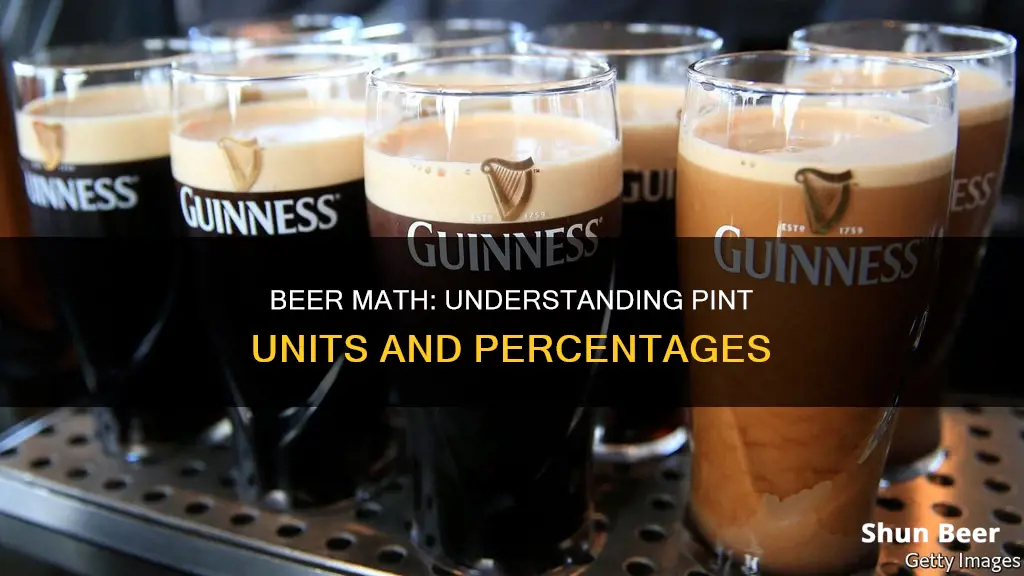
Many people enjoy a pint of beer, but it's important to keep an eye on your alcohol consumption. A unit is a metric that calculates the amount of pure alcohol in a drink. In the UK, one unit is equal to 10ml or 8g of pure alcohol. This is the amount of alcohol the average adult can process in an hour. So, how many units are in a pint of 5% beer?
| Characteristics | Values |
|---|---|
| Number of units in a pint of 5% beer | 2.8 units |
| Formula to calculate units | strength (ABV) x volume (ml) ÷ 1,000 = units |
| Volume of a pint | 568ml |
| Definition of a unit | 1 unit = 10ml or 8g of pure alcohol |
| Time to metabolise 1 unit of alcohol | ~1 hour |
| Recommended maximum alcohol consumption per week | 14 units |
What You'll Learn

A unit of alcohol is 10ml or 8g of pure alcohol
In the UK, a unit of alcohol is defined as 10ml or 8g of pure alcohol. This is the amount of alcohol that the average adult can process in about an hour. After an hour, there should be little to no alcohol left in the bloodstream. This amount varies from person to person.
The concept of a unit of alcohol was introduced in the UK in 1987 to help people keep track of their drinking and better understand the risks associated with alcohol consumption. It is a simple way to express the quantity of pure alcohol in a drink, taking into account both the size of the drink and its alcohol strength.
The number of units in a drink can be calculated using the formula: strength (ABV) x volume (ml) ÷ 1,000 = units. For example, a pint of strong lager with an ABV of 5.2% contains 2.95 units of alcohol.
The UK's Chief Medical Officers have published guidelines recommending that men and women should not drink more than 14 units of alcohol per week on a regular basis to keep health risks at a low level. This is equivalent to about 6 pints of average-strength beer or 10 small glasses of lower-strength wine.
It is important to note that the definition of a standard drink or unit of alcohol varies from country to country. In the US, for example, a standard drink typically contains around 14 grams of alcohol. Understanding how many units of alcohol are in your drink is crucial for monitoring your alcohol consumption and maintaining a balanced lifestyle.
Beer for Wedding Guests: How Many Pints to Buy?
You may want to see also

A pint of 5% ABV beer contains 2.8 units of alcohol
A unit of alcohol is a metric used to calculate the amount of pure alcohol in a drink. In the UK, one unit of alcohol is equal to 10ml or 8g of pure alcohol. This is the amount of alcohol that the average adult can process in an hour. Therefore, within an hour, there should, in theory, be little to no alcohol left in the blood of an adult. However, it is important to note that this can vary from person to person based on factors such as body size, age, gender, and metabolic rate.
The number of units in a drink is based on both the size of the drink and its alcohol strength. The formula to calculate the number of units in a drink is:
Units of alcohol = (ABV x volume in ml) ÷ 1,000
For example, a pint of beer is typically around 568ml in volume. If the ABV of the beer is 5%, then the calculation would be as follows:
5% ABV x 568 ml ÷ 1,000 = 2.84 units
Therefore, a pint of 5% ABV beer contains approximately 2.8 units of alcohol. It is worth noting that this calculation assumes a pint of beer with a volume of 568ml. The actual volume of a pint can vary slightly depending on the specific drink and serving size.
Understanding the number of units in a drink is important for monitoring alcohol consumption and staying within recommended guidelines. In the UK, the recommended maximum amount of alcohol for adults to consume per week is 14 units, spread across multiple days. This is the limit advised by the UK government to keep health risks from alcohol at a low level.
Cider vs Beer: What Sets Them Apart?
You may want to see also

It takes an hour for the body to metabolise one unit of alcohol
A unit of alcohol is a metric used to calculate the amount of pure alcohol in a drink. In the UK, one unit contains 10ml or 8g of pure alcohol. This is the amount of alcohol that the average adult can process in an hour. This means that, in theory, after an hour there should be little to no alcohol left in the bloodstream of an adult. However, it is important to note that this will vary from person to person.
The speed at which the body processes alcohol depends on several factors, including weight, age, gender, body composition, genetics, and health. The liver is the primary organ responsible for alcohol detoxification. It releases enzymes to break down alcohol, but it can only metabolize a small amount at a time, so the excess circulates throughout the body. The more alcohol consumed, the higher the intensity.
Alcohol is absorbed directly into the bloodstream through the tissue lining of the stomach and small intestine. Food in the stomach can inhibit the absorption of alcohol by physically obstructing it from coming into contact with the stomach lining. Additionally, food can either absorb alcohol or simply take up space, reducing the amount of alcohol that enters the bloodstream.
The number of units in a drink depends on the size of the drink and its alcohol strength. For example, a pint of lager with an alcohol content of 5.2% ABV contains 2.95 units of alcohol. On the other hand, a pint of standard-strength lager with an ABV of 4.5% contains 2.5 units of alcohol.
It is important to monitor alcohol consumption to maintain a balanced lifestyle and reduce potential health risks associated with excessive drinking.
Stout vs Beer: What's the Difference?
You may want to see also

The recommended weekly alcohol limit in the UK is 14 units
In the UK, a unit of alcohol is defined as 10ml or 8g of pure alcohol, which is the amount the average adult can process in about an hour. The UK introduced the idea of counting alcohol units in 1987 to help people keep track of their drinking. The number of units in a drink depends on the size of the drink and its alcohol strength. For example, a pint of strong lager has 3 units, while the same volume of lower-strength lager has just over 2 units.
It is important to note that drinking any level of alcohol increases the risk of a range of cancers. The likelihood of alcohol damaging your health depends on how much you drink. Consuming less than 14 units a week is considered low-risk drinking.
To calculate the number of units in a drink, you can multiply the volume of the drink in millilitres by its ABV (alcohol by volume) and then divide the result by 1,000. For example, a 5% ABV pint of beer (568ml) would contain about 2.95 units of alcohol.
Barrel Breakdown: Pint Glasses in Half a Beer Keg
You may want to see also

Drinking five pints of 5% ABV beer exceeds the recommended weekly limit
In the UK, a unit of alcohol is defined as 10ml or 8g of pure alcohol, which is the amount the average adult can process in about an hour. This is a useful way to keep track of your alcohol consumption and stay in control of your drinking.
A pint of beer typically contains 2.3 to 2.95 units of alcohol, depending on its strength. A 5% ABV beer is stronger than average-strength beer, so we can assume it contains around 2.8 units per pint. Therefore, five pints of 5% ABV beer would contain around 14 units of alcohol.
The UK Chief Medical Officers' guidelines recommend that men and women should not drink more than 14 units of alcohol per week to keep health risks at a low level. This is equivalent to around six pints of average-strength beer. Therefore, drinking five pints of 5% ABV beer in a week exceeds the recommended limit and increases the risk of alcohol-related health problems.
To reduce the risk of alcohol-related harm, it is important to spread your drinking over three or more days and have several drink-free days each week. Drinking less alcohol can also provide several health benefits, such as lower blood pressure, reduced risk of stroke and cancer, and improved mood and energy levels.
The Perfect Pint: Beer's Liquid Measure
You may want to see also
Frequently asked questions
A pint of 5% beer contains 2.8 units of alcohol.
You can calculate the number of units in a drink by multiplying the volume of the drink in millilitres (ml) by its ABV (alcohol by volume, expressed as a percentage), and then dividing that number by 1,000.
For example, a pint of beer (568ml) with 5% ABV would be calculated as follows:
568 x 5 / 1,000 = 2.84, or 2.8 units.
The recommended number of units of alcohol per week is 14, for both men and women. This is equivalent to around 6 pints of 4% beer.
It takes the body approximately one hour to metabolise (break down) one unit of alcohol. This will vary depending on body size, age, gender, metabolic rate, etc.







